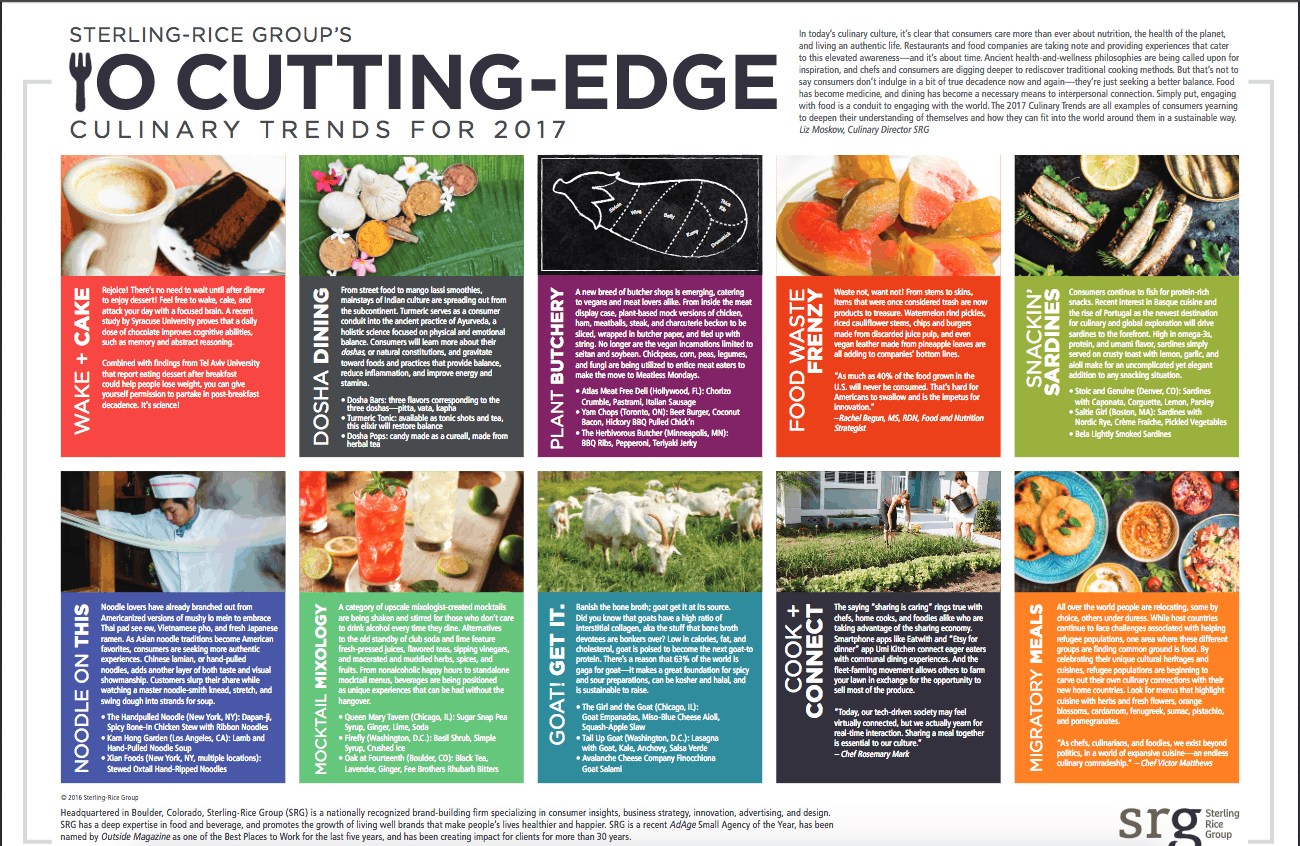
Consumers next year may be eating chocolate at breakfast, sardines with lunch and goat for dinner, according to a new list of culinary trend predictions by Sterling-Rice Group. With nutrition, sustainability and authenticity top of mind, consumers are seeking to rediscover traditional cooking methods and explore global cuisines, and restaurants and packaged food companies are taking note, said Liz Moskow, culinary director at Sterling-Rice Group.
“Simply put, engaging with food is a conduit to engaging with the world,” she said. “We look at what’s happening in the economy, what’s happening in the digital space, what’s happening in the greater world, and then come up with what we call culinary shifts, anything from sustainability to food as medicine,” Moskow told Food Business News. “The more touchpoints a trend has, the more ability to ‘go viral,’ the way that we see it as trending in the real world and not on-line.”
Wake and cake
Recent studies linking dark chocolate consumption to positive health benefits may encourage more consumers to indulge in the a.m. "We predict that breakfast might start seeing brunch amuse-bouche chocolate cakes or brunch and breakfast restaurants incorporating a robust dessert menu,” Moskow said.
Restaurants should talk up their darkest chocolate to the 11.6% of adults who dine out or order takeout at least three times in a typical week, according to AudienceSCAN data.
Dosha dining
The remarkable rise of turmeric as a trending ingredient in recent years has become a gateway to American exploration of Ayurveda. “Indians believe in the concept of dosha, which is another word for your body’s set constitution,” Moskow said.
Plant butchery
"Chickpeas, corn, legumes and fungi are standing in for steaks in an emerging crop of butcher shops with products designed to appeal to vegans and carnivores alike."
Cater to the meatless Frequent Diners with television (over-the-air, online, mobile or tablet) spots, because 50.3% of them took action after watching commercials in the past month, the AudienceSCAN study found.
Food waste frenzy
"Consumers and companies alike are creatively reducing food waste by repurposing typically tossed-out stems, skins and rinds."
Snackin’ sardines
In restaurants, the rise of toast’s popularity presents an opportunity to offer sardines as a topper. “Sardines are high in omega‑3 fatty acids, high in protein, high in umami flavor, all things that are trending,” Moskow said.
Noodle on this
"Offering authentic taste and showmanship, hand-pulled noodles are hot in big-city Chinese restaurants."
Restaurants can spotlight sardines and noodles in direct mail to Frequent Diners. The AudienceSCAN study found 45.6% of patrons took action after receiving ads/coupons in their mailboxes in the past month.
Mocktail mixology
"Mocktails are getting a modern makeover, with such offerings featuring fresh-pressed juices, flavored teas, sipping vinegars and muddled herbs and spices."
‘Goat’ get it
Belly up to goat, potentially the next hot protein to hit plates in the United States. “Goat has much less fat than most other forms of meat, including chicken, it’s high in protein, 63% of the world already consumes goat, and with the rise in goat’s milk products, we think people may be willing to take the leap at this point,” Moskow said.
Cook and connect
"Likened to businesses like Uber and Airbnb, a new app and web site called EatWith connects home cooks with hungry strangers. Another aspect of the trend is fleet-farming, a movement allowing aspiring gardeners to farm another’s lawn in exchange for a cut of the produce sales."
Connect with Frequent Diners via mobile smartphone app ads or text message ads, because AudienceSCAN research revealed they are 91% more likely than average consumers to take action after receiving these.
Migratory meals
Refugee populations are planting culinary flags in their new home countries, inspiring unique fusions of flavor and heritage. “Where we’re seeing this now the most is in war-torn Middle East, with Afghanis, Syrians, Persians all fleeing the area and their food culture trickling down and out,” Ms. Moskow said. “What we think is really going to start to happen is this Middle Eastern fusion cuisine led by Persian influences, with pomegranate, sour cherries, sumac, fenugreek, orange blossom… and then combining the base of that with more traditional Afghani cuisine. Not just hummus and kabob, but these more delicate flavors.”
AudienceSCAN data is available as part of a subscription to AdMall for Agencies, or with the SalesFuel API. Media companies can access AudienceSCAN data through the AudienceSCAN Reports in AdMall.
